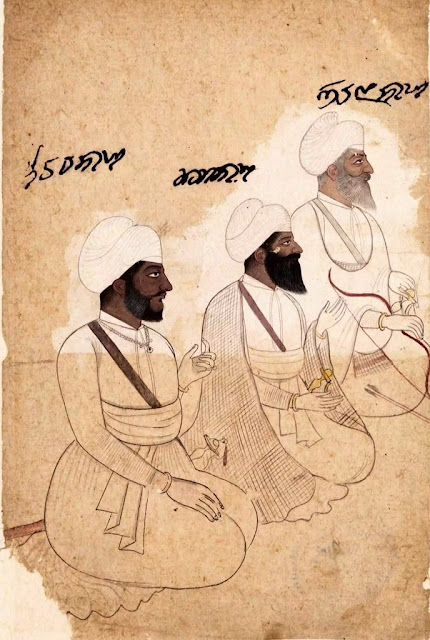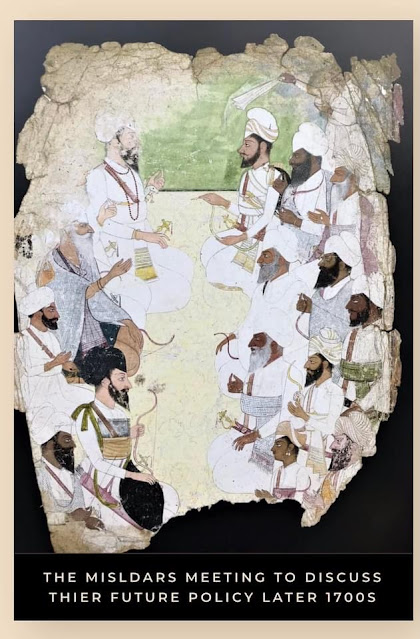Major James Browne of the East India Company and correspondence with the Bhangi Sardars in 1783.
Link to Major James Browne’s India Tracts written in 1787 where he mentions the powerful Sikh chiefs of Lahore at page 111 (Lehna Singh, Gujjar Singh and Sobha Singh)…includes a history of the Sikhs.
He was based at Agra, but ordered by William Hastings who was based at Calcutta to proceed to Delhi to make sure the Emperor did not make a deal with the Sikhs in 1783…the Sikhs having besieged the City under Sardar Baghel Singh (that’s why we have all the Gurdwaras in Delhi!).
https://archive.org/details/dli.csl.5294/page/n111/mode/2up?q=Lahore
He says “The city of Lahore is at present divided among the three most powerful chiefs, who share the revenue arising from all imports and duties, &c. within the city, including the mint ;• the names of the present possessors are, Gujer Sing, Sabah Sing, and Laina Sing”
He goes on to say that the Chiefs gathered at Amritsar and decided their campaigns for that season and chose the commander.
The plunder collected during these expeditions was divided amongst the chiefs according to the number of their followers, to whom the chief made his own distribution.
Where a district was not totally under their control, they levied protection money called Rakhi ie a tax at 20% which was low compared to the Mahrattas 25%…which enabled the zaminders to thrive.
In return for the Rakhi, no other Sikh chief would bother the Zamindar.
They called their confederacy KhalsaJi or the state, and the army was known as Dal KhalsaJi.
He says “Trade however, is in a low state, owing to the insecurity of merchants going backwards and forwards through the territories of so many independant chiefs.
Of their manufactures, the principal are very fine cloth, which they make at Lahore, as also the best arms in Hindustan.
Their cavalry is remarkably good, the men Being very hardy and well armed with sabres and excellent matchlocks, which they use with great dexterity; the horse bred in their country, are of one of the best breeds in the empire, owing to the use formerly made there of Arabian and Persian stallions, and something in the temperature of the air and water of that country. Most of these soldiers have two or three horses each, by which means their incursions are made with great rapidity, their armies marching from fifty to one hundred and twenty miles a day :—-their dress is dark blue, as ordered by Guru Gobind, and gives them, when collected in large bodies together, a very difmal appearance .
The chiefs are only distinguishable from their followers, by finer horses and arms.
I have conversed with several Sicks, who were sent to me by different chiefs on complimentary messages ; and I perceived a manly boldness in their manner and conversation, very unlike the other inhabitants oi Hindustan, owing no doubt to the freedom of their government.
In their camps they use no tents, even the chiefs are sheltered by nothing more than small Numgheras (square canopies of coarse cotton cloth) supported on four slender poles—the common soldiers pitch .a blanket on two sticks, and fasten the corners down to the ground with wooden pins, so that they encamp or decamp in a few minutes.
Among their customs, the following are remarkable :
They will not use tobacco, though its usage is universal to all the inhabitants of Hindustan, yet they drink spirits and smoke Bang (the leaves of hemp) to the greatest excess of intoxication.”
Says that in 1785, the Sikhs made a treaty with the Maratha Mahadji Scindhia that if either party conquered territories any side of the Jumna it would belong to the Khalsa.
https://ia800603.us.archive.org/22/items/TheMarathaSikhTreatyOf1785Dr.GandaSingh/The%20Maratha-Sikh%20Treaty%20of%201785%20-%20Dr.%20Ganda%20Singh.pdf
Dr Gurinder Singh Mann in his book “The British and the Sikhs” also mentions that letters written in Persian were sent by Major James Browne to all the Sikh Sardars including Sardar Lehna Singh of Lahore via their vakil at Delhi Lakhpat Rai - and replies were received expressing willingness to cooperate with the British.
The correspondence of Major James Browne with the Sikh Sardars including Lehna Singh Kahlon of the Bhangi Misl shows he admired the "Manly Boldness" of the Sikh Sardars which he puts down to their being from a free people.
" Correspondence with the English, April, 1783
James Browne was an agent of Warren Hastings, the governor-general.
He first lived at Agra and then came to DeIhi. His main object was to see that Mughal Emperor, Shah Alam II, should not surrender himself to· the Sikhs.
From Agra Browne wrote to Baghel Singh who was then controlling the imperial capital. His vakil (Lawyer) Lakhpat Rae posted at the Emperor's court, informed Browne that notable Sikh chiefs such as Jassa Singh Ahluwalia "who is the
"highest and greatest and in that country called Badshah Singh" and Baghel Singh including many others were willing to establish friendly " relations with the British Government.
Browne's reply dated 27 April, 1783, held out prospects of "sincere friendship" on the condition of their not plundering the Ganga Doab and the crownlands.
Lakhpat Rae sent another letter enclosing with it letters from Jassa Singh Ahluwalia, Lahna Singh Bhangi of Lahore, Baghel Singh from Delhi and Sahib Singh of Patiala. They contained declarations of mutual goodwill and co-operation.
About the conduct of these messengers Browne wrote: "I have conversed with several Sikhs, who were sent to me by different chiefs on complimentary messages, and I perceived a manlly boldness in their manner and conversation, very unlike the other inhabitants of Hindostan owing no doubt to the freedom of their government."
Source : History of the Sikhs, Volume 4, Page 40 by Hari Ram Gupta.
Jassa Singh Ahluwalia sat on the Mughal Throne as "Badshah Singh and the Dal Khalsa was happy to see him crowned ...but it seems Jassa Singh Ramgharia was not happy to see him become Emperor, according to Hari Ram Gupta :
"In the Red Fort, Delhi, March, 1783The Dal Khalsa under Jassa Singh Ahluwalia advanced upon Delhi in March, 1783. By this time Jassa Singh Ramgarhia had also built up his fortunes in the Hansi-Hisar region. He joined the Dal Khalsa in the neighbourhood of Delhi: The Dal entered the Red Fort on March 11, 1783, and placed Jassa Singh Ahluwalia on thethrone of Mughal Emperors. They called him Badshah Singh. Jassa Singh Ramgarhia challenged him. Both sides drew out swords. The Ahluwalia sardar stepped down the throne and declined the honour. But he could not bear this insult and humiliation. It told upon his health which declined rapidly."
Jassa Singh Ramgarhia was an enemy of Sardar Jassa Singh Ahluwalia - will post on that later!


Comments
Post a Comment